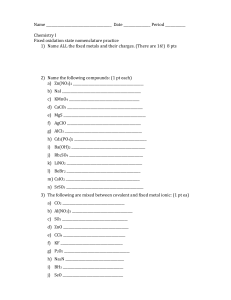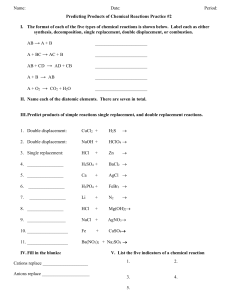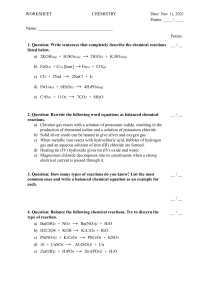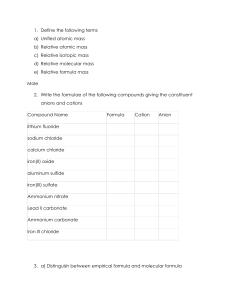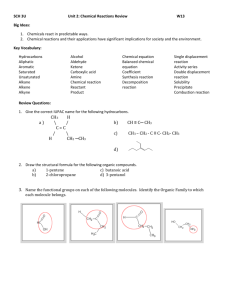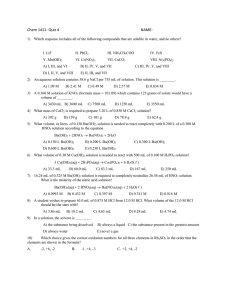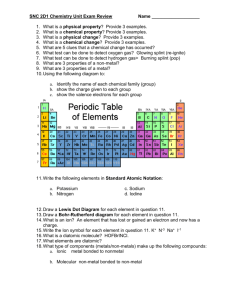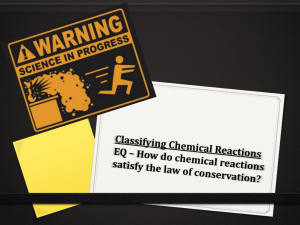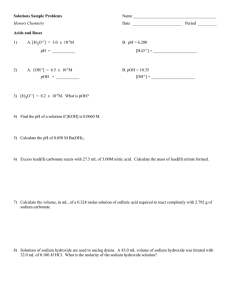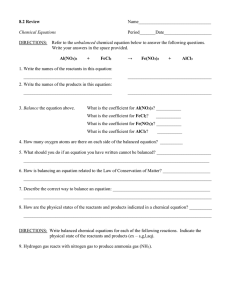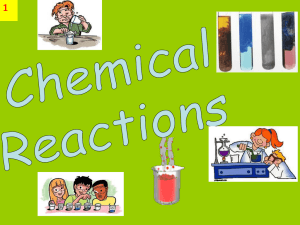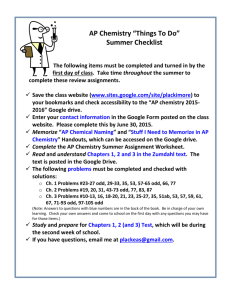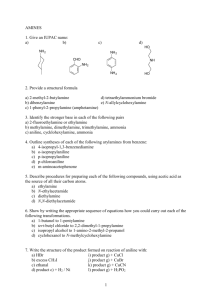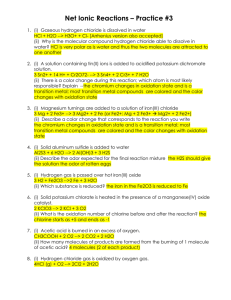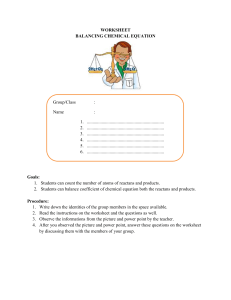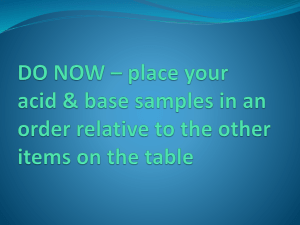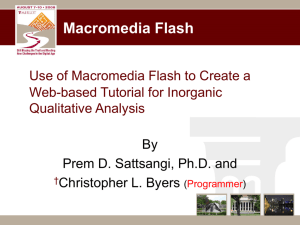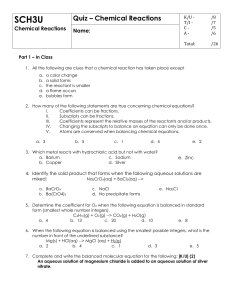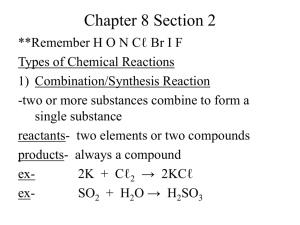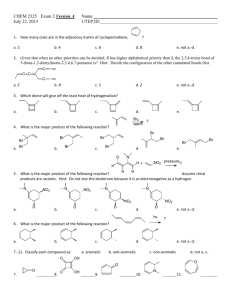Ch 21 Practice Test Propane - C3H8 (g) – reacts with oxygen gas to
advertisement
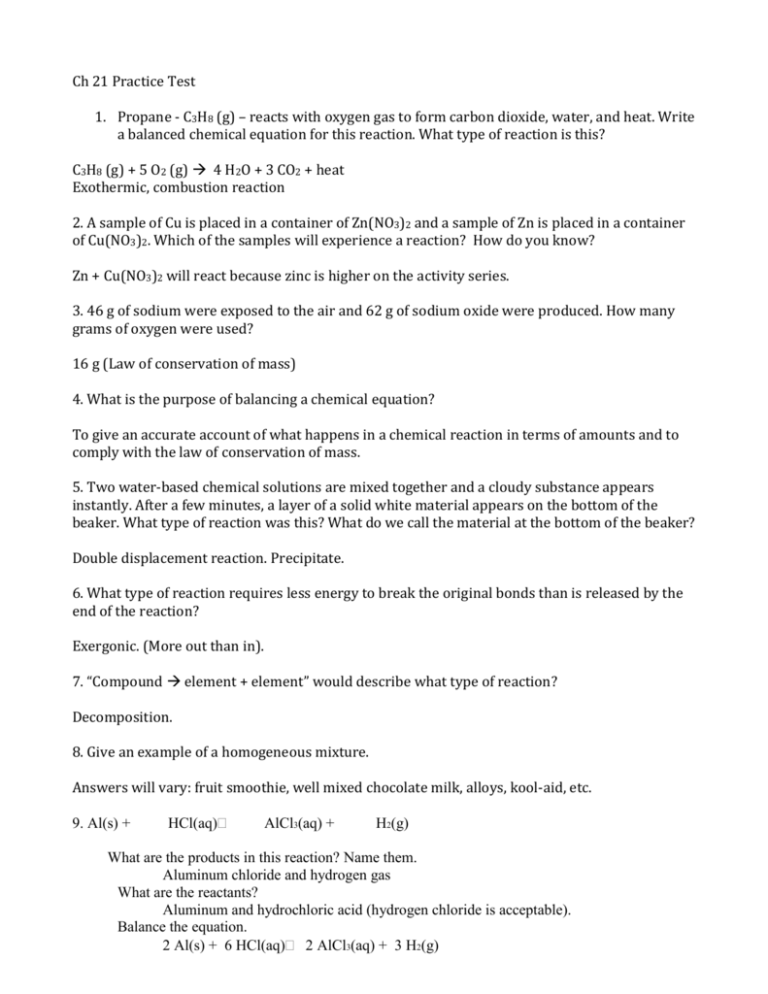
Ch 21 Practice Test 1. Propane - C3H8 (g) – reacts with oxygen gas to form carbon dioxide, water, and heat. Write a balanced chemical equation for this reaction. What type of reaction is this? C3H8 (g) + 5 O2 (g) 4 H2O + 3 CO2 + heat Exothermic, combustion reaction 2. A sample of Cu is placed in a container of Zn(NO3)2 and a sample of Zn is placed in a container of Cu(NO3)2. Which of the samples will experience a reaction? How do you know? Zn + Cu(NO3)2 will react because zinc is higher on the activity series. 3. 46 g of sodium were exposed to the air and 62 g of sodium oxide were produced. How many grams of oxygen were used? 16 g (Law of conservation of mass) 4. What is the purpose of balancing a chemical equation? To give an accurate account of what happens in a chemical reaction in terms of amounts and to comply with the law of conservation of mass. 5. Two water-based chemical solutions are mixed together and a cloudy substance appears instantly. After a few minutes, a layer of a solid white material appears on the bottom of the beaker. What type of reaction was this? What do we call the material at the bottom of the beaker? Double displacement reaction. Precipitate. 6. What type of reaction requires less energy to break the original bonds than is released by the end of the reaction? Exergonic. (More out than in). 7. “Compound element + element” would describe what type of reaction? Decomposition. 8. Give an example of a homogeneous mixture. Answers will vary: fruit smoothie, well mixed chocolate milk, alloys, kool-aid, etc. 9. Al(s) + HCl(aq)AlCl3(aq) + H2(g) What are the products in this reaction? Name them. Aluminum chloride and hydrogen gas What are the reactants? Aluminum and hydrochloric acid (hydrogen chloride is acceptable). Balance the equation. 2 Al(s) + 6 HCl(aq)AlCl3(aq) + 3 H2(g) What type of reaction is this? Single displacement What do the symbols indicate about the states of the products? Al is solid, HCl is dissolved in water, AlCl3 is aqueous and hydrogen is a gas. 10. What is an activity series? How can it be used to predict chemical reactions? An organized list of elements based on how chemically active elements are. It can be used to predict what elements will displace other elements in single displacement reactions. 11. Give 3 chemical properties of water and 3 physical ones. For the physical ones – identify at least one intensive and one extensive. Chemical – H2O. non-flammable, doesn’t react to light, Physical – density of 1 g/mL, transparent, liquid at room temperature, a sample might have a mass of 100 g. 12. What causes the Tyndall effect to happen? The particles in a colloid are larger than those in a solution and can deflect light particles, showing the beam of light. 13. If I have a piece of cake, what is one physical change I could do to it? What is one chemical change? Physical – cut it, smash it, chew it, blend it, etc, Chemical – digest it, pour acid on it, etc. 14. Give five examples of things you might observe that may suggest a chemical change occurred. A light produced Temperature change Change of state independent of temperature Color change Odor produced Sound produced Gas produced New properties 15. Give one similarity and one difference between catalysts and inhibitors. Both change the rate of reaction. Both are unaffected by the reaction and are the same after as they were before. A catalyst speeds up the reaction and an inhibitor slows down a reaction.
